#b2b research
Text
Difference between B2B and B2C Market Research
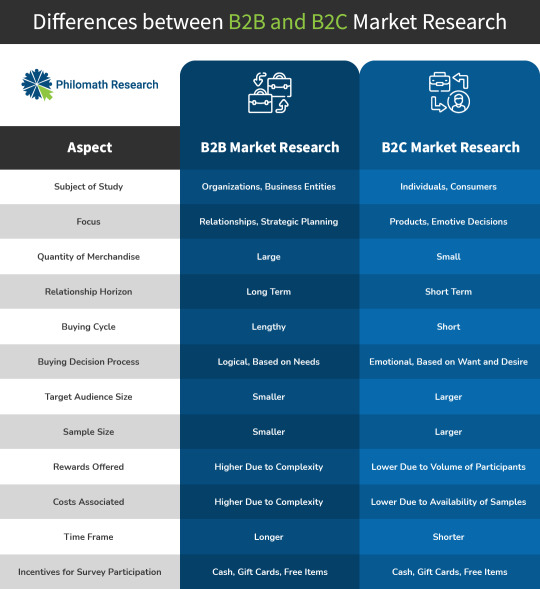
0 notes
Text
Best Practices for Conducting B2B Quantitative Surveys
The panel responds to business-related surveys to assist in information gathering, problem solving, and long-term industry insight.Let’s discuss how B2B panels can be used for market research for your company.
Here’s the Audience view on best practice in conducting B2B surveys yourself.
#1.Clearly define your business objective
Ask yourself the following questions:
What are my goals for the survey?
How will I use the information that results from the survey?
What specific information do I need to reach these goals?
Then, put your goals and motivations into a brief statement and include any specific details you’ll need to succeed in achieving them.
These information objectives’ sequencing and wording are unimportant. At this point, being thorough is the only objective.
#2. Specify the sample size and target audience in detail:
B2B decision-making is frequently complicated because it often involves several people. Consider which roles to ask about in the survey.
Usually, you want to get in touch with the people who ultimately decide whether or not to purchase the research’s target product category.
Consider the variety of organisations you would like to respond in a similar manner. For instance, you might have chosen to concentrate on any US SMB.
The interviews must be representative of the US SMB population in order for the research to be useful. That would entail make sure there is a mix of various sectors and size segments.
Decide how many interviews are necessary after defining the target audience. The results will be statistically more reliable the more interviews there are.
However, the target audience might be so small that conducting a large number of interviews would require extremely high budgets. Increase the number of interviews as much as you can, but be sensible about what is practical.
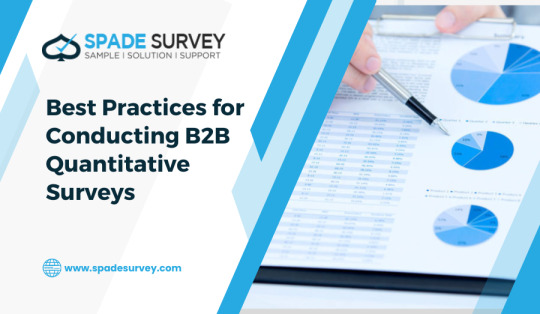
#3. Decide on the survey methodology
Surveys for B2B market research can be completed over the phone, online (on a laptop or mobile device), or in person.
In B2B research, face-to-face surveys are frequently unrealistic unless you’re conducting interviews at a significant conference or event.
Even then, this is only true if the study is focused on that particular event or if the target audience as a whole is likely to attend. Otherwise, the participants will favour those who will be present.
Online surveys frequently prove to be a very economical method for conducting quantitative research. They are typically easy to set up and carry out.
They aren’t always attainable or realistic, though. There are times when conducting surveys over the phone is necessary (also called CATI).
The design of the questionnaire should take into account the dynamics of each approach. Online surveys, for instance, can use a variety of question types but typically need to have shorter questions (e.g., conjoint exercises are possible).
4. Choose your reward strategy for the target audience.
B2B decision-makers are a limited resource, especially when the study concentrates on people who hold senior or specialised positions.
They are scarce, but that’s not the only issue. It can be difficult to win over decision-makers’ support. They are shielded by gatekeepers, have a finite amount of time, and are more interested in expanding their business than conducting research.
However, if you employ the proper strategy, you can encourage B2B respondents to participate in the study.
People buy from people in the majority of B2B markets, and buyers and sellers typically have positive interactions. Utilizing this connection is the most potent inducement available.
Interrogating a decision-curiosity maker’s is another effective soft incentive. Decision-makers are more likely to consider participating if the research topic or method sounds interesting.
Because B2B respondents have limited time, it’s critical to stress that the time they do invest in the research will pay off in the long run. We advise highlighting how involvement in research will benefit them, their employer, or both through innovations or service improvements.
In our experience, a combination of soft and hard incentives works best when trying to persuade time-constrained decision-makers to take part in research.
#5.Create the questionnaire structure
Writing surveys calls for two distinct abilities:
Detail-oriented writing is required when creating survey questions and responses.
However, if the questionnaire structure is flawed, even well-written questions are useless. Respondents might lose interest in the survey if the order of the questions causes them confusion.
These are distinct abilities that draw on various cognitive processes. No one can do both well at the same time, and few people are able to do both well. Writing questions necessitates such attention to detail that questionnaire authors lose sight of the overall structure’s big picture.
Your ability to successfully complete both tasks is increased when you approach each skill as a separate step. It also enables you to speak with coworkers who might excel in each skill. As an illustration, you request that a coworker with exceptional attention to detail review the question’s wording.
#6. Write the questions
You must create the actual questions once you are familiar with the structure of the questionnaire. When doing so, make sure to avoid common mistakes:
Avoid leading questions. Check your question wording frequently to make sure you are not unintentionally or knowingly leading respondents to a specific answer.
Remove ‘double-barrelled’ questions. Bad surveys frequently ask participants to provide feedback on multiple items with a single response.
Avoid the overly complicated survey question. Although the survey is intended for B2B decision-makers, a typical consumer should be able to understand the questions. This means that to prevent any jargon misunderstandings, the language used should be straightforward.
Avoid repetitive questions. Similar to lengthy questions, repetitive questions may drive respondents away from the survey. Repeated survey questions can also irritate respondents and produce unreliable results. Imagine, for instance, that two questions in an online survey are nearly identical, but one word has been changed. In this case, the survey may contain an error because the respondent might believe that the questions are identical.
Don’t ask for too much personal information. It makes sense that B2B decision-makers are reluctant to divulge sensitive information about their company. There is a limit to how much information respondents are willing to share, even if you can assure them that the survey is genuine. Therefore, if you request too much sensitive information, they will withdraw.
#7. Pilot the survey
Sending the survey to friendly clients or coworkers is advised. Keep it as straightforward as you can; you can just send a draught in the format you’re using (e.g., Word).
You can steer clear of errors like the ones mentioned above thanks to their advice. It will also give you a good idea of how long it will actually take respondents to finish the survey.
#8. Launch and manage the survey
There are typically five ways to start a survey in B2B research:
Sending it via email – This strategy is cost-free and lets you choose who takes part in the survey. The popularity of your brand and the quality of your bond with the email contacts will both affect the response rate.
Calling respondents – This strategy is comparable to email distribution. It gives participants choice, and the response rate is influenced by how well-established the connections are with those on the list.
Buying respondents through a panel this strategy appears to work well in theory. Since participants in the research have already agreed to participate, you usually know in advance how many responses you will receive.
Embedding the survey in a website or newsletter -By placing the study in front of a potential respondent when they are close to the brand or product category covered by the questions, you may be able to collect responses.
#9. Process and analyse the results
Once a survey is comprehensive, the temptation is to start immediately doing analysis and building a report.
The possibility is to begin analysis and report-building as soon as a survey is finished.
However, this might result in poor-quality research reports:
Before you begin analysing the data, you must format and check it; otherwise, you will be referring to inaccurate or incomplete data.
Before you begin writing the report, you must analyse the data and determine the story. By doing this, you can prevent the narrative from being unclear or the report from being overly lengthy.
Start by looking at your data. You are looking for the following:
People who haven’t adequately responded to all the questions
People who “flat-lined,” or finished the survey too quickly by simply answering the questions without giving them much thought
Those whose responses are illogical, such as those who claim to have never heard of Brand X while also declaring it to be their preferred brand. Nevertheless, mistakes do happen. You probably shouldn’t have permitted that combination in the questionnaire.
Spade Survey is a B2B market research and B2B survey firm located in India. Our market research company has conducted many B2B studies across the country with a variety of industries.Contact our team to receive a quote for a market research project Email-id:[email protected].
0 notes
Text

AD Marketing Ltd is a leading provider of high-quality marketing data solutions for businesses in the United Kingdom. For more information visit > marketingdatalists.co.uk
#market#research#b2b#marketing#data#driven#b2bemail#directmail#buytargetedemaillists#b2bservices#datamarketing#businessdata#uk#unitedkingdom
3 notes
·
View notes
Text
Data Entry & Lead Generation Expert Service

#data entry#web research#microsoft excel#b2b lead generation#b2c lead generation software#copypasta#virtual assistant#real estate agent
1 note
·
View note
Text
If you are in trouble converting your documents into an editable word file, then I can help you. message my inbox without any hesitation. I have been a Professional Data entry, Web research, and File conversion expert for more than two years. Message my inbox or contact me on Fiverr; https://www.fiverr.com/jawad245

#advertising#data entry#file conversion#web research#my writing#data scraping#pdf#pdf to word#pdf to excel#lead generation#b2b lead generation#copy paste#typing#image to pdf#image to word#handwriting#handwriting to word#content writing#marketing#email collection#ms excel#my words#news#nonprofits#physics#poets on tumblr#nature#motivation#menswear#existence
2 notes
·
View notes
Link
My Name is "Saniya" I have 5+ years of experience in Any type of Lead Generation.
Targeted Lead generation, Email List Building, Linkedin Lead Generation, Web Research and Data Entry Expert.
My Service:
👉Lead Generation (B2B)
👉Targeted B2B Leads
👉Linkedin Lead Generation
👉Internet Research
👉Web Research
👉Data Entry
👉Real Estate Lead
👉Email Finding From a Website
👉Copy Paste Work
Order Now: https://cutt.ly/3KJn225
#data entry services#b2b#b2b lead generation#internet#email list building#linkedin lead#copy paste#business lead#socialmediamarketing#digital marketing#Reall estate Lead#web research#targeted lead
5 notes
·
View notes
Text
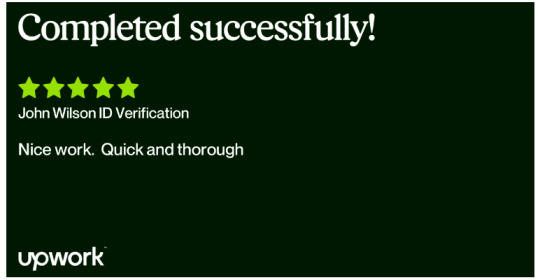
OSINT Investigator, Background Check of Individuals and Company & B2B Lead Generation Expert
https://lnkd.in/gbiz7SM7
https://lnkd.in/gmdT8NFU
I provide my service as a
B2B Lead Generation Expert
Cyber Security Expert
Private Investigator
Background Check Specialist
Target Discovery
Legal Researcher
Social Media Researcher
GeoLocate / Locate a Person
Business Researcher
Subject Researcher
Online Research and Reporting
Due Diligence
Data Researcher
Digital Forensics Researcher
Product Research
Information Researcher & Tracking
OSINT Researcher & OSINT Expert
Data Verification
Identity Verification
Online Tracking
News Researcher
Scam Investigator
Online Researcher
Market Researcher
#osint investigator#osint expert#due diligence#internet research#online investigator#lead generation#lead generator#b2b lead generation#b2bmarketing#b2b#marketing
1 note
·
View note
Text
B2B E-Commerce Market: AI-led Transformation & Latest Updates

As per the US Bureau of Labor Statistics, American families dedicate six hours every week to household planning and shopping, much of which occurs online at Walmart. As the world’s largest retailer, Walmart generated over $82 billion in e-commerce sales in 2023. This shows that the majority of B2B e-commerce transactions are shifting to a digital platform. Accordingly, our analysis predicts that the Global B2B E-Commerce Market is set to rise at a CAGR of 22.98% over the forecast years 2024-2032.
B2B E-Commerce Market: AI’s Dominant Force
AI enables highly personalized shopping experiences by analyzing customer data and predicting purchasing behavior. This leads to more effective targeting of consumers and higher conversion rates. With a wide database, AI systems can predict inventory needs, deal with supply chain management, and optimize warehouse operations to reduce costs and improve efficiency.
Additionally, AI algorithms analyze market conditions, demand preferences, and competitor pricing to suggest optimal pricing strategies in real time. It also helps in detecting and preventing fraudulent transactions by analyzing patterns and flagging unusual activities.
In order to leverage these benefits, B2B e-commerce companies utilize Artificial Intelligence (AI) as a service to enhance their operations worldwide.
Explore in detail about this market in our FREE sample
How AI Enhances B2B E-commerce platforms for Companies?
Adobe Sensei: Part of the Adobe Experience Cloud, Sensei uses AI and machine learning to deliver real-time insights into customer behaviors, optimize marketing campaigns, and improve content effectiveness.
SAP Leonardo: This digital innovation system integrates AI capabilities into the SAP Cloud Platform, supporting machine learning, analytics, and blockchain technology, which enhance the capabilities of B2B e-commerce businesses.
Oracle AI: Oracle’s AI solutions offer capabilities from automated customer service agents to advanced analytics and data management systems designed for complex business environments.
Recent years have witnessed significant in B2B e-commerce trends, driven by technology and changing business needs. Modern B2B e-commerce platforms are integrating AI to improve user experiences and operational efficiency.
B2B E-Commerce Market: Generative AI’s Unmatched Presence
Generative AI offers innovative B2B e-commerce solutions to enhance product presentation, especially for generic products that might otherwise be overlooked. Here are some key applications of generative AI in e-commerce to improve customer experience and operational efficiency:
Customizing product designs that better match customer expectations
Automating the creation of unique and compelling product descriptions based on specifications and reviews
Optimizing dynamic pricing strategies in real time by analyzing competitor prices, demand trends, and inventory levels
Here are some notable acquisitions and partnerships integrating Generative AI:
Walmart and Microsoft Azure Partnership in January 2024 enhances Walmart’s B2B e-commerce platform using Microsoft Azure’s cloud computing capabilities. This new capability is designed specifically to understand the context of a customer’s query and generate personalized responses.
One of the reasons Walmart and other leading retailers are opting for Azure OpenAI Service is the access it provides to the world’s most advanced AI models, coupled with the robust enterprise-grade features and regional availability.
IBM and SAP collaboration stated their plans on May 8 2024, to extend collaboration to help clients evolve into next-generation enterprises with generative AI. Initially, IBM intends to integrate AI capabilities across SAP’s range of cloud solutions and applications.
This strategic partnership also aims to deliver financial solutions for the CFO’s office, supply chain management solutions, human capital management solutions, SAP Customer Experience solutions, and intelligent spend management solutions.
Innovation in Salesforce: In 2023, the company unveiled a groundbreaking innovation with Einstein GPT, marking a milestone as the inaugural generative AI CRM technology globally. This tool redefines customer interactions across sales, service, marketing, commerce, and IT by generating AI-driven content.
In simple terms, Einstein GPT empowers sales teams to craft personalized emails, enables customer service representatives to swiftly address inquiries with tailored responses, assists marketers in generating highly targeted content to boost campaign engagement, and aids developers by automatically generating code.
Looking Ahead…
Generative AI is revolutionizing B2B e-commerce websites by offering personalized experiences, automating content creation, and streamlining the purchasing process. These advancements enhance customer satisfaction and improve operational efficiency for businesses. With the integration of advanced technologies and a shift towards sustainability, businesses are finding unparalleled opportunities for growth and innovation in the B2B e-commerce industry.
Grab a Quick Read to Understand the Comprehensive Outlook of the B2B E-commerce Market:
FAQs
Q.1) What is the future of B2B e-commerce?
B2B commerce is experiencing a significant transformation as traditional sales models are rapidly becoming obsolete, with the majority of B2B transactions between suppliers and buyers moving to digital platforms. With the help of AI, within the next decade, every product and service shall offer a digital shop, purchase, or self-serve option.
Q.2) What are the key characteristics of B2B e-commerce?
The characteristics of a B2B e-commerce website are Wholesale purchases, customized pricing, Advanced Payment Method, Restricted access, etc.
0 notes
Text
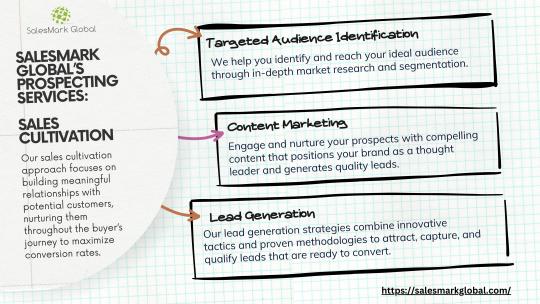
Salesmark global’s prospecting services: Sales Cultivation
SalesMark Global is your reliable partner for achieving exponential growth and optimizing your internet presence. Our entire portfolio of sales cultivation and performance marketing services is designed to help your company generate leads, enhance conversions, and achieve long-term success in today's competitive digital world.
Visit Salesmark Global’s “Prospecting” for more details
Explore into SalesMarkBlog for Strategies That Propel Your Success Beyond Limits!
#Prospecting#Performance Marketing#Performance Marketing Services#data-driven strategies#sales cultivation#customer journey#SEO#content marketing#customer satisfaction#customer retention#b2b buyer#b2b buyer's intent#lead generation#lead generation strategies#market research#market segmentation#b2b marketing#account based marketing#abm strategy#abm#data analytics#abm agency
0 notes
Text
Crafting Effective Strategies through B2B Market Research & Analysis
Introduction
In the dynamic landscape of business-to-business (B2B) interactions, staying ahead requires more than just intuitive decision-making. It demands a deep understanding of market dynamics, customer behaviors, and industry trends. This is where B2B market research and analysis emerge as indispensable tools for businesses striving to thrive in competitive environments. In this comprehensive guide, we delve into the significance of B2B market research & analysis, uncovering how it fuels the formulation of effective strategies for sustainable growth.
Understanding B2B Market Research & Analysis
At its core, B2B market research entails the systematic gathering, interpretation, and analysis of data related to the business environment in which a company operates. This encompasses various facets including market size, competitor analysis, customer preferences, technological advancements, regulatory frameworks, and economic trends. Through meticulous examination of these factors, businesses gain invaluable insights that inform strategic decision-making processes.
The Crucial Role of B2B Market Research & Analysis
Identifying Market Opportunities: B2B market research enables organizations to identify untapped market segments, emerging trends, and evolving customer needs. By discerning gaps in the market, businesses can tailor their offerings to meet specific demands, thereby gaining a competitive edge.
Understanding Customer Behavior: Central to B2B success is understanding the intricate nuances of customer behavior. Through in-depth analysis of purchasing patterns, decision-making processes, and pain points, businesses can refine their marketing strategies and enhance customer engagement.
Competitor Analysis: A thorough understanding of the competitive landscape is imperative for devising effective strategies. B2B market research empowers businesses to assess competitor strengths and weaknesses, anticipate market moves, and capitalize on opportunities that arise.
Mitigating Risks: In an ever-evolving business environment, risks abound. B2B market research equips organizations with the insights needed to identify potential threats, mitigate risks, and adapt swiftly to changing market conditions.
Informing Product Development: By soliciting feedback from existing and prospective clients, businesses can refine existing products or develop new offerings that resonate with customer needs. B2B market research provides the foundation upon which innovative products and services are built.
Crafting Effective Strategies through B2B Market Research & Analysis
Define Objectives: Before embarking on any research endeavor, it is essential to outline clear objectives. Whether it’s penetrating a new market segment, launching a product, or enhancing customer satisfaction, clearly defined goals serve as guiding beacons throughout the research process.
Select Methodologies: B2B market research encompasses a myriad of methodologies ranging from surveys and focus groups to data analytics and social listening. The selection of appropriate methodologies hinges on the nature of the research objectives, target audience, and available resources.
Gather Data: Once methodologies are chosen, the next step involves gathering relevant data. This may involve primary research through direct interactions with customers and stakeholders, or secondary research utilizing existing sources such as industry reports, market surveys, and academic literature.
Analyze Findings: With data in hand, the focus shifts to analysis. This stage involves synthesizing information, identifying patterns, and drawing meaningful insights. Advanced analytics techniques such as regression analysis, cluster analysis, and predictive modeling may be employed to extract actionable insights from complex datasets.
Develop Actionable Strategies: Armed with insights gleaned from analysis, businesses can formulate actionable strategies tailored to their unique objectives and market dynamics. These strategies should be grounded in data-driven evidence and aligned with organizational goals.
Implement & Monitor: Implementation marks the culmination of the strategic planning process. However, the journey doesn’t end here. Continuous monitoring and evaluation are essential to gauge the efficacy of strategies, identify course corrections, and seize new opportunities as they arise.
Conclusion
In the fast-paced realm of B2B commerce, success hinges on the ability to navigate complexity, anticipate change, and capitalize on opportunities. B2B market research & analysis serve as indispensable tools in this endeavor, empowering businesses to make informed decisions, mitigate risks, and drive sustainable growth. By embracing a systematic approach to research and strategy formulation, organizations can unlock the full potential of their B2B endeavors, setting the stage for enduring success in an ever-evolving marketplace.
Remember, in the world of B2B, knowledge truly is power, and with the right insights at your disposal, the possibilities are limitless.
For further assistance with B2B market research & analysis, feel free to reach out to Philomath Research, where expertise meets excellence.
FAQs
1. What is B2B Market Research & Analysis?
B2B Market Research & Analysis involves the systematic gathering, interpretation, and analysis of data related to the business environment in which a company operates. This includes understanding market dynamics, customer behaviors, competitor landscapes, and industry trends.
2. Why is B2B Market Research & Analysis important?
B2B Market Research & Analysis is crucial for businesses to identify market opportunities, understand customer behavior, assess competitors, mitigate risks, and inform product development. It provides insights that drive strategic decision-making processes, ultimately leading to sustainable growth and competitive advantage.
3. What are some key components of B2B Market Research & Analysis?
Key components include defining objectives, selecting appropriate methodologies (such as surveys, focus groups, and data analytics), gathering data through primary and secondary research, analyzing findings, developing actionable strategies, and implementing and monitoring those strategies.
4. How can businesses benefit from B2B Market Research & Analysis?
Businesses can benefit from B2B Market Research & Analysis by gaining insights to tailor their offerings to meet specific market demands, enhance customer engagement, anticipate market moves, mitigate risks, and develop innovative products and services that resonate with customer needs.
5. What are some common methodologies used in B2B Market Research & Analysis?
Common methodologies include surveys, interviews, focus groups, data analytics, social listening, and secondary research utilizing industry reports, market surveys, and academic literature.
6. How can Philomath Research assist with B2B Market Research & Analysis?
Philomath Research offers expertise in B2B Market Research & Analysis, providing comprehensive services to help businesses navigate complexity, make informed decisions, and drive sustainable growth. Our team of experts utilizes advanced methodologies and analytical techniques to deliver actionable insights tailored to your unique objectives and market dynamics. Feel free to reach out to us for further assistance and consultation.
#B2B Market Research & Analysis#B2B Market Research#B2B Market Research Services#B2B Market Research Firm#B2B Research#B2B Market Research Company
0 notes
Text
Don't let your SEO efforts stay grounded!
At Bizionic, we specialize in crafting tailored keyword strategies that will propel your business to new heights. 🚀 With comprehensive research and competitive analysis, we'll ensure your brand rises above the competition. Contact us today for a consultation!
#digital marketing services#keyword strategy#keyword research services#key phrases#keyword targeting#seo content strategy#b2b seo strategy#enterprise seo strategy#international seo strategy#seo content marketing strategy#branding strategy#brand strategy consulting#brand strategy firm#brand visibility#startup financing for small businesses#startup business insurance#cleaning business startup#recovery startup business#startup photography business
0 notes
Text

Lead Generation Services in India
Boost your business growth with our expert lead generation services in India. Get high-quality leads and increase your sales with our professional lead generation services in India.
#lead generation#top market research companies in india#best b2b lead generation services#top lead generation companies in india#business growth#leads generation#top lead generation companies & services#data analytics and consulting services
0 notes
Text
B2B Panels
Our B2B Panels undergo thorough profiling, considering various criteria including the panelist's functional roles, decision-making authority, industry sub-segment, organization size, and job titles.
0 notes
Text
E-Commerce Business: Sustainable Partnership Between Turkey and Nigeria
The cooperation between Nigeria and Turkey stands out as a model of creativity and long-term collaboration in the quick-paced, border-blurring world of e-commerce. These two countries are establishing a remarkable precedent for sustainable practices in the online business sector as they work together to leverage the power of digital connectivity and promote economic growth. This investigation explores the dynamic relationship between Turkey and Nigeria in the context of e-commerce, highlighting the partnerships that are fostering this relationship and placing particular emphasis on TurkAfrica Market significant contributions.

#connection#nigeria#networking#market research#places#ecommerce#writing prompt#b2b#b2b ecommerce#business growth#investing#turkey#commercial#entrepreneur#south africa#artificial intelligence#Turkey
0 notes
Text
B2B E-Commerce Market: Comprehensive Outlook for 2024-2032
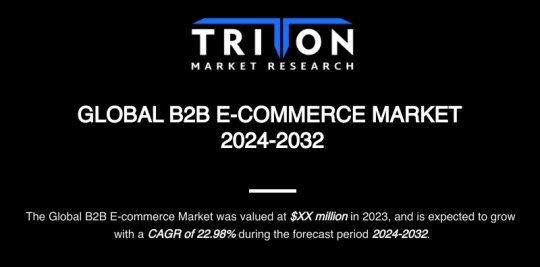
As per the triton market research, the Global B2B E-Commerce Market report is segmented by Category of Supply (FMCG, Maintenance, Office Supplies, Industrial, IT Products, Manufacturing, Janitorial and Sanitation, Repair), Deployment Type (Buyer-Oriented, Supplier-Oriented, Intermediary-Oriented), Channel (Market Place Sales, Direct Sales), End-User (Information Technology, Transportation and Logistics, Construction, Telecom and Media, Automotive, Manufacturing, Retail and Distribution), and Regional Outlook (Asia-Pacific, North America, Europe, Middle East and Africa, and Latin America).
The report highlights the Market Summary, Industry Outlook, Porter’s Five Forces Analysis, Market Attractiveness Index, Regulatory Framework, Key Market Strategies, Market Drivers, Challenges, Opportunities, Competitive Landscape, Research Methodology and scope, Global Market Size, Forecasts & Analysis (2024-2032).
According to Triton’s report analysis, the global market for B2B E-Commerce is estimated to advance with a CAGR of 22.98% in revenue over the forecasting years 2024-2032.
The global B2B E-Commerce market encompasses a range of digital platforms, software, and solutions designed to facilitate transactions and interactions between businesses. Through these channels, companies can efficiently buy, sell, and exchange products, services, and information.
The accessibility of high-speed internet, cloud computing, and mobile devices has fostered seamless connectivity and transactional capabilities for businesses worldwide. In fact, the advent of secure payment gateways, digital signatures, and encryption technologies has facilitated the secure exchange of financial transactions. These factors influence the growth of the B2B E-Commerce market during the forecast period.
However, as businesses exchange sensitive details on these online portals, safeguarding this information from unauthorized access and cyber threats is vital. Neglecting to institute adequate security measures can lead to financial setbacks and a breakdown of trust. Furthermore, adhering to ever-changing data privacy laws and industry-specific security protocols becomes a challenge for companies engaged in B2B E-Commerce.
The Asia-Pacific B2B E-Commerce market is expected to witness the fastest growth during the forecast period. The increasing use of mobile technology, widespread digital transformation across sectors, and strategic investments drive this growth. The emergence of new business models in this region provides comprehensive insights into consumer behavior and preferences in order to deploy targeted strategies and elevate customer engagement.
The prominent entities in the B2B E-Commerce market are Amazon, Alibaba, IndiaMART, Flipkart, eBay, Walmart, Shopify, Costco Wholesale Corporation, Dangdang, and JD.com.
A notable trend in this market is the swift uptake of AI and machine learning for predictive analytics. This enables companies to anticipate customer needs, enhance pricing strategies, and personalize the overall shopping experience for B2B customers.
0 notes